Gerry Spehar joined Captain Michael and me for a short trip in the Jonesport area. In Jonesport we enjoyed a visit with "Joe", the
harbormaster in East Jonesport. He took good care of us as usual while spewing out numerous grumpy barbs to all concerned, especially Captain Michael.
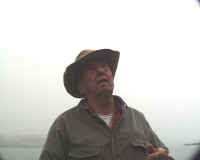
 Joe delivers a
harangue in the fog.
Joe delivers a
harangue in the fog.
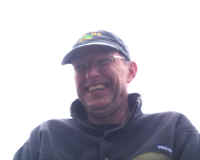
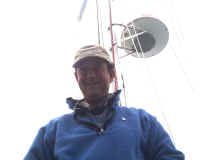 Gerry
and Michael endure the harangue gracefully.
Gerry
and Michael endure the harangue gracefully.

We sailed through Roque Island, one of my favorite spots in Maine on our way to Trafton Island. I had not visited this cove before, and it was a
nice spot, although it seemed a little exposed. Gerry showed great promise as a sailor, a natural capacity cowboys seem to have for some reason. I
think it is the familiarity with rope, familiarity with large somewhat uncontrollable and unpredictable forces that arise when dealing with large
animals like horses, and an instinctive sense for weather conditions that may contribute to the natural ability of cowboys on sailboats. My dad, who
worked on a ranch and is a good horseman, also has quickly grasped many of the needed tasks and has a sense for the judgments involved.
We spent the next night in Mistake Island Harbor. We were expecting a storm to come through that night with winds of about 25 knots. When we
entered the harbor, we decided a good spot to anchor would be in front of a small island that might protect us from the expected southwesterly winds.
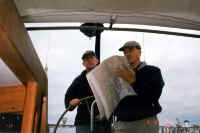
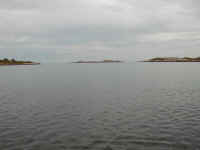 Entering
Mistake Island Harbor.
Entering
Mistake Island Harbor.
We arrived early in the afternoon and still had a few hours before the storm was to hit. I was interested in taking the P. Ellen out to do some
exploration. We had not made it to the Mud Hole, a beautiful harbor nearby, the year before due to an unexpected fuel filter leak and being boarded by
the Coast Guard in Roque Island Harbor. Although the tides were not in our favor this year for bringing Chaos into the Mud Hole, I thought we might
have time to take the P. Ellen across the Mud Hole Channel and make it into the Mud Hole.
We set off knowing we would need to hurry back if we had any early signs of the storm's approach. The wind was about right for the P. Ellen, 10 to
15 knots. As we went by some of the large rocks at the entrance to Mud Hole Channel from Mistake Island Harbor, about two dozen seals we had been
eyeing, and who were carefully watching us, suddenly started to bark loudly and all simultaneously entered the water. The sound they were making
seemed quite aggressive and made us suddenly wonder if seals ever attacked little dinghies like ours en masse. They swam out to about 10 or 20 yards
off and all stuck their heads and necks out looking us over very closely. I wondered if they had young to protect over on the rock. We were relieved
to be beyond them, although it seemed remote that they would approach us.
We were able to make it across the Mud Hole Channel, a distance of about two nautical miles, and entered the Mud Hole. We had to row in the last
bit, as the wind died past the entrance. We landed on the rocks on one side to have a quick lunch, take a picture or two, and celebrate our return to
the Mud Hole. The wind started to change a little, as we were eating our lunch, and the skies looked a touch more gray. We quickly decided to cut
short any hiking or other activity on Great Wass Island and set off for Mistake Island Harbor. On the way back the seals questioned our presence
again, and the waves and wind were clearly unsettled. We were happy to be back on Chaos for the evening.
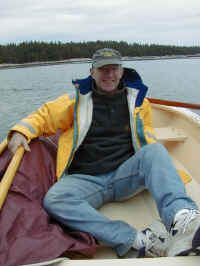 On
our way to the Mud Hole in the P. Ellen.
On
our way to the Mud Hole in the P. Ellen.
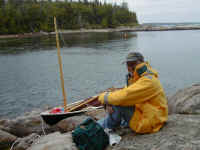
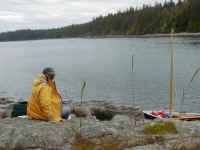

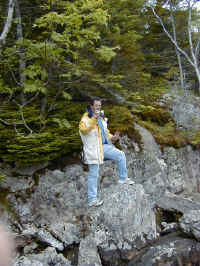
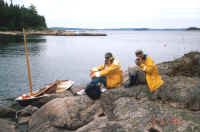 The
Mud Hole above and left.
The
Mud Hole above and left.
As the light began to fade we saw an eagle perched on a rock nearby. He circled our cove while we finished dinner.
As the storm came up, I set the anchor alarm on the GPS for 200 feet. We had about 90 feet out and had backed down on the anchor. We had no reason
to believe we should have any trouble, as the anchor seemed well set in. I had read about some problems with kelp beds in this harbor in one of the
guides, although the comments weren't dramatic in any way. We all went to bed after a good dinner, as the storm began to howl.
I awakened to a beeping noise near my head, which was only a few feet from the navigation panel. I got up in a bit of a fog and squinted at the GPS.
The anchor alarm had been tripped. I found this hard to believe and wondered if we had just swung around and set it off somehow. As I manipulated the
display to try to understand why the alarm had tripped and I began to wake up, I realized the GPS was telling me we had already moved 300 ft downwind.
I called Michael to wake him up. We climbed up on deck and tried to understand in the darkness where we were. Yes, we had dragged anchor and were all
the way on the other side of the harbor. Fortunately we had missed a couple of rocks that were abreast a few hundred feet on either side of us. We
were in an area with lots of lobster buoys, so I was imagining a fouled anchor chain below us.
We still had rain and 25 knot winds with some higher gusts. We had to figure out what to do. First we let out almost all of our chain. It seemed
the anchor was now holding well again. The rocky cliffs along the leeward side of the harbor seemed alarmingly close now. We were of a mind to pick up
the anchor and move back to the other side of the harbor, but Gerry weighed in with concern about the risk of moving vs. the apparent stability of our
position. Why not just wait until morning? After some further thought, we decided to run hourly anchor watches until dawn. We kept the engine on, so
we were ready to drive the boat to windward and take up the chain if we started to drag again.
We hauled up the anchor in the morning when the winds were light. It would have been a difficult operation in the dark with strong winds, so I
think we made a good decision to hold out until the storm had died down and we had light winds. We found several lobster buoy lines wrapped on our
chain that we carefully untangled. We also had large amounts of kelp vines wrapped around the chain and to the anchor flukes themselves. If we had
tried to do this in the dark with the strong winds still blowing, we would have been trying to maintain boat position in the dark with our bow being
blown downwind while trying to untangle barely visible lines and vines.
In retrospect, we learned setting two anchors would have been a good idea in this area where kelp was mentioned as a problem and when we were
expecting some strong winds. In particular, Dan recommended our Danforth anchor might have helped with the kelp. I will be prepared to react more
quickly to the GPS anchor alarm next time. We probably should have started with more of our anchor chain out, as well. Finally, we may have actually
backed down too aggressively on the anchor according to Joe in Jonesport. He says leaving the engine in gentle reverse for a period of time is more
effective for getting the anchor to dig in and really set itself.
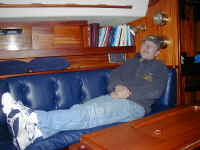

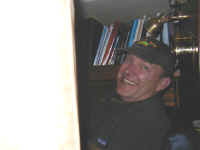
Looking good and unaware of the all night anchor watch we were facing.